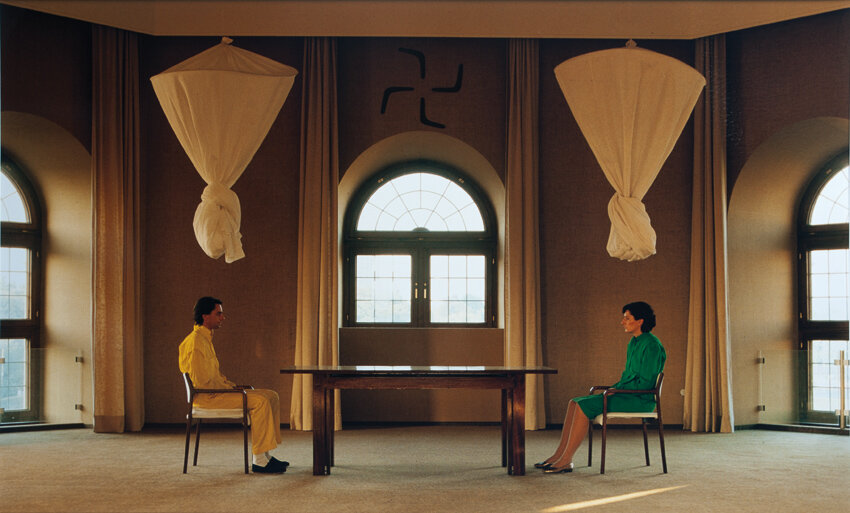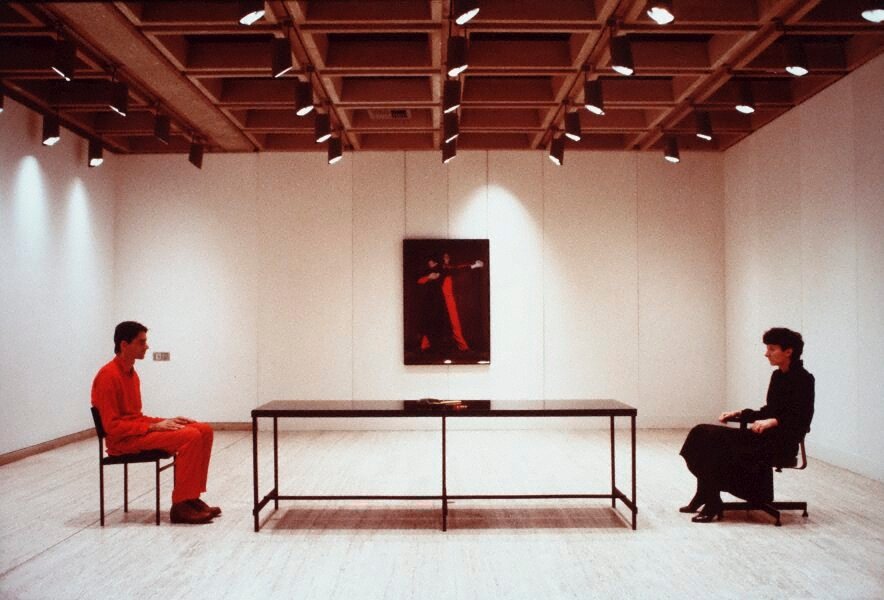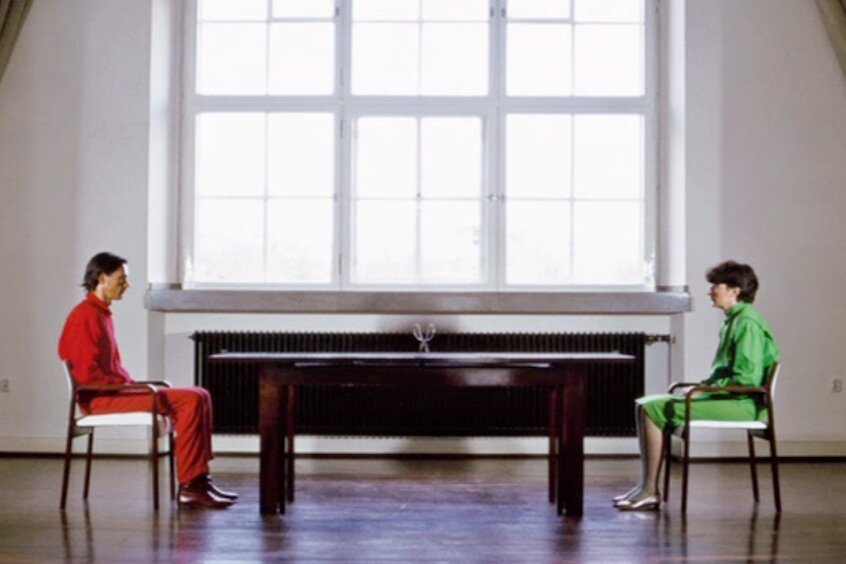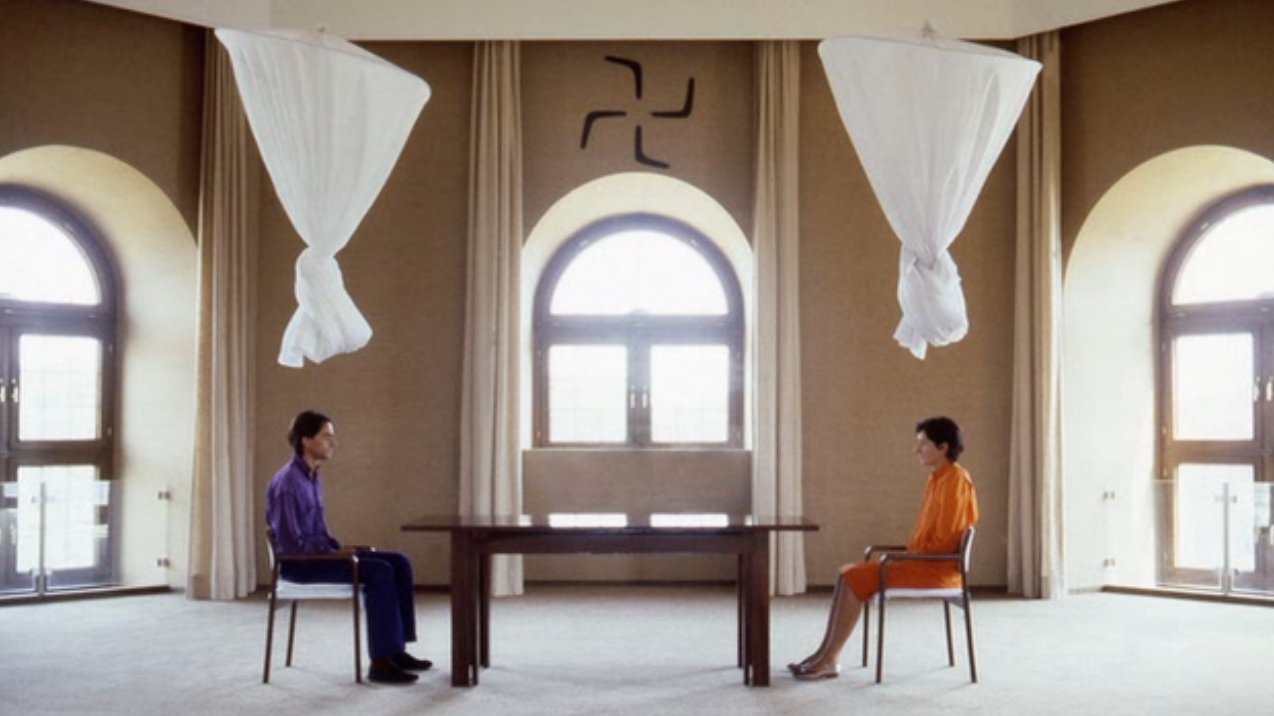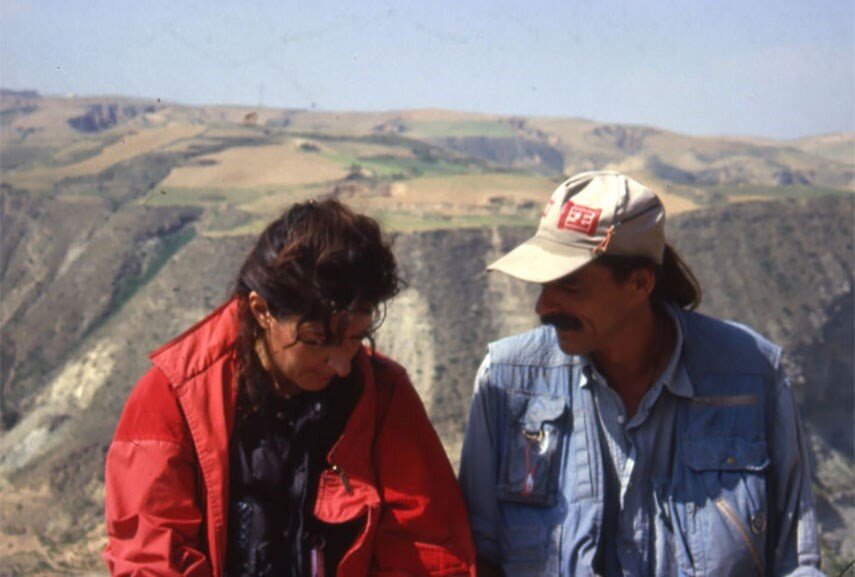The Story of Marina Abramovic and Ulay
Photo Credit: Cobosocial
After hearing about the passing of German performance artist Ulay at the age of 76, I knew I had to pay tribute to his work with his ex partner Marina Abramović. While the time of their separation is dated back in 1988, their former bond - which resulted in some of the most influential and iconic moments in art history of the modern generation - lives on in the hearts of many - including myself.
Back in 2010, my parents took me on a trip to New York City that I will never forget. From the Broadway shows, to the view from the Empire State Building, I checked off a lot of boxes on my bucketlist. But the most memorable part of the trip was witnessing Marina Abramović perform The Artist is Present live at the MoMA. At the time, my teenage self had never heard of her. But after hours of wandering her exhibit and learning more about her, she and her former partner Ulay truly opened my mind to performance art, modern art, and what it means to think deeply and look inside oneself.
In the future, I can write articles that go more in-depth about Abramović’s early life and influence, but today I’d like to focus on her relationship with Ulay and its impact on culture.
Early Lives
Hailing from Serbia, Abramović’s studied at the Academy of Fine Arts in Belgrade in the mid-’60s, completing post-graduate work at its sister school in Croatia. Abramović then returned to Serbia, where she taught at the the Academy at Novi Sad while developing her first solo performances. Ulay - originally Frank Uwe Laysiepen from Solingen Germany - began his career as an artist in the early ‘70s after moving to Amsterdam, where he began creating self-portrait polaroid collages that delved into gender as a construct, which were seen as controversial at the time. Ulay and Abramović first met in 1976. They soon moved in together and began collaborating artistically.
The main focuses of their works were ego and identity. Their work resulted in a collective, which they refer to as “The Other.” As part of this collective they started to dress and behave alike in order to develop a completely trusting relationship. After some time, their own identity or sense of self became less and less decipherable. The following collaborations are the results of this unconventional union.
Infamous Collaborations
In Relation in Space (1976)
In this performance, Abramović and Ulay repeatedly ran into each other from across the camera’s frame, gaining speed and force each time. They’d continuously knock each other over, with Ulay later stating that they were black and blue by the end of it. The purpose of this piece was to combine male and female energy, in order to create a third component, which they called “that self.” To see a snippet and hear commentary from Abramović and Ulay themselves, watch the video below.
Relation in Movement (1977)
Relation in Movement is one of Abramovic and Ulay’s lesser-known works - probably because it’s one of the few performances where they themselves are not easily visible. In this performance, the pair drove their car around an empty museum room for 365 laps. While Ulay drove the car, Abramović counted and announced each lap over a megaphone. Abramović recalls that during one of their performances of this piece, the motor burned out and created a black circle on the marble floor. Abramović had stated that the idea was that the car might collapse, or they might collapse themselves. But after the 365th lap, it signified an imaginary year for them. To see a snippet, watch the video below.
Relation in Time (1977)
For this performance, Abramović and Ulay had their ponytails tied together, sitting back to back for hours on end. They first sat in that position in the museum without anyone else present (except for a photographer who took the odd photo of the status of their joint ponytail,) and once they got to the point where they could take it no longer, they invited museum visitors to view them. They wanted to see if having an audience could push them to stay longer, and succeeded with one extra hour back to back.
Photo Credit: Dazed
Breathing In/Breathing Out (1977-1978)
In Breathing In/Breathing Out, Abramović and Ulay connected their mouths with a piece they had devised, plugged their noses with cigarette filters (forcing them to breath through their mouths) and breathed into each other’s lungs over and over again until they used up all available oxygen and were only breathing carbon dioxide. Once both of their sets of lungs were filled with carbon dioxide, the couple collapsed to the floor, unconscious. To see a snippet, click here.
Photo Credit: Art Zoo
Imponderabilia (1977
For Imponderabilia, Abramović and Ulay stood completely nude across from one another in a doorway, with just enough space for an average sized person to squeeze past between them, but not without having to brush up against them both. The test is to see if the subject chooses to face Abramović - the woman, or Ulay - the man. Some are more comfortable facing the person of their same gender, while others choose to face the person of the gender they’re attracted to, and others have a completely different take on what made up their mind.
This performance was on display at the MoMA, this time modeled by two of Abramović’s students. My mother and I opted out of walking between the models, however my father did it, choosing to face the woman. I honestly couldn’t tell you which person I’d choose to face if given the opportunity once again to participate. I think it’d have a lot to do with the vibe I got from either individual in the moment.
Photo Credit: Dazed
AAA-AAA (1978)
In AAA-AAA, Abramović and Ulay stand across from one another with their mouths wide open, making the loudest, longest and most intense yelling sounds possibly. As time passed, they came closer and closer to each other until they eventually were yelling into each other’s mouths. The performance lasted around 15 minutes, with their yells falling out of sync from exhaustion. The purpose of the piece was to showcase endurance and the dynamic between man and woman. To see a snippet , click here.
Photo Credit: Artsy
Rest Energy (1980)
Rest Energy - my personal favorite collaboration of theirs - involved Abramović and Ulay leaning with all their bodyweight, hanging onto opposite ends of a drawn bow and arrow, with the arrow aimed directly at Abramović’s chest. With just one slip of his fingers, Ulay could potentially kill Abramović. Ulay having the power to let go of the arrow was intended to symbolize man’s assumed dominance over women. And Abramović’s handle on the bow was meant to symbolize her own power as a woman to determine the outcome of the situation. I love the idea behind this symbolism, but what makes this piece even more meaningful to me is how much she trusts Ulay to keep a steady hand and a level head as he carries her life in his hands.
Photo Credit: MoMA
Nightsea Crossing (1981-1987)
Abramović and Ulay performed Nightsea Crossing times in various locations all over the world. In these performances, they each sat facing each other in the same chairs across the same long mahogany dinner table, motionless in a “state of tranquility” for many hours at a time. This piece is meant to highlight the idea that while your body may be staying still, your mind can wander and function intensely. Abramović has been quoted stating that Nightsea Crossing was the beginning of the end for them, and that during one performance, when Ulay was unable to match her endurance, he gave up, leaving her to face an empty chair. And if this performance sounds familiar to you at all, you are two steps ahead of me!
The Lovers
Photo Credit: Dazed
The Nightsea Crossing performance timeline framed a very significant period in the couple’s relationship. Around 1980 when they first began performing it, they decided to get married - and they wanted to celebrate their union in one of the grandest romantic gestures I’ve ever heard performed in the modern day: walking from opposite ends of the Great Wall of China towards each other, in order to meet in the middle before wedding. They reached out to the Chinese Governmental for permission to carry out their performance, and waited for years to hear back. In the meantime, the couple drifted further and further from each other due to infidelities and irreconcilable differences among other issues.
Around 1987, they were finally granted permission to scale the entirety of the wall. While they had already separated as a couple, they agreed to carry on with their plans, and each walk across half the wall to each other until meeting in the middle - when they would instead say their final goodbye.
They each embarked on their 3-month long trek from opposite ends of the ~13,170 mile wonder of the world, Abramović starting at the Yellow Sea and Ulay starting from the Gobi desert. They stayed at inns along the way and communicated with their personal Chinese translators.
Abramović has expressed in the past that part of her longed for a reconciliation between them when the performance had completed. But as the two of them met at the center of the wall, her longing for him as a romantic partner was in many ways replaced by strong feelings towards him as a comrade and fellow artist. It was an emotional finish for the both of them, as they knew it would be their last collaboration. However, this emotional time was made more complicated when Abramović was given the news that during the trek, Ulay had impregnated the Chinese translator who had accompanied him. Abramović has expressed that she was utterly heartbroken when she made the discovery.
The daughter born out of the relationship was not Ulay’s first child. He has admitted to impregnating two women in the late ‘60s/early ‘70s and cutting ties with them both, as well as the two sons who resulted from those unions. He handled his relationship with the translator much differently, moving her to Amsterdam right before her due date and the Tiananmen Square massacre of 1989. He helped her deliver their child - a daughter he named Luna after seeing the moon hanging prominently over the clinic on the night she was born. The couple stayed together for many years, traveling the world with Luna until she reached 17, when Ulay said his goodbyes to both women.
While Abramović has been married twice - to Neša Paripović from 1971 to 1976 and to Italian contemporary artist Paolo Canevari from 2006 to 2009, she has never had any children. She has explained to media outlets that she has endured three abortions in her lifetime, feeling that having children would be “a disaster for [her] work.” She’s expressed that she believes that part of why women historically haven’t had the same opportunities and successes as men is because of commitments to their love lives and children.
Photo Credit: Public Delivery
The Artist is Present
Photo Credit: Open Culture
In 2010, Abramović presented many of her most famous life works in a larger than life exhibit at the MoMA in New York that visitors such as myself will never forget. Before the exhibit, she trained 30 performance artists on how to carry out her work for the months that the exhibit was on display. She hosted them for a workshop at her home in the Hudson Valley during which she had them turn over their phones and other electronic devices to her and gear up for days of fasting, sleep deprivation, nude cohabitation and meditation in order to rid themselves of any self-consciousness that they may naturally harbor as a performer, and slow their bodies and minds down to be able to endure her most taxing performances. One of the artists she trained quoted her: “We’re not going to eat or speak for three days. You’ll hate me at the time, but you’ll love me forever after and do whatever I want.” To learn more about the exhibit, check out its official documentary here.
The main attraction of the exhibit was the portion that Abramović herself would be involved in: The Artist is Present. Similarly to Nightsea Crossing, from the moment the museum opened to the hour it closed, she would sit at a chair across a table from another chair, which guests visiting the museum could take turns sitting at, to gaze into her eyes without saying a word, while being watched by hundreds of other museum visitors. The idea of the performance was that she would be able to deeply connect with the person sitting across from her without saying anything, bringing a large portion of the ~1000 participants to tears with just a gaze. While she was initially met with criticism for the concept, the performance was a major hit, which thousands of MoMA visitors lined up to participate in for hours and hours. It’s now become one of the most famous exhibits to ever take place at the museum.
While photographs of many of her participant interactions garnered media coverage, her reaction to one particular guest not only went viral, but stole the attention of art communities all over the world: Ulay.
The morning that Ulay visited the MoMA, he popped in for a visit with Abramović after 22 years apart. And later on in the day, he surprised her by participating in The Artist is Present. When Abramović opened her eyes to view her next participant and realized it was Ulay, she smiled bashfully. The two former lovers gazed into each others eyes, emotions presumably racing, with Abramović finally reaching across the table to hold his hands. The crowd around them burst into applause and cheers for the reunion of this iconic pair. As Ulay got up and walked away from the table, Abramović wiped tears from her face. The genuinity and emotion of the moment moved audiences around the world and will live on in the hearts of many following his recent passing. To watch their interaction, check out the video below.
The Later Years
Photo Credit: Artnet
I wish I could say that things between Abramović and Ulay were smooth-sailing from there, but in 2015 Ulay filed a lawsuit against Abramović, claiming that she had violated a contract they had for their shared works. Abramović was ordered by a Dutch court to pay Ulay $280,500 in royalties.
I am happy to say that things turned around for their relationship in 2017, when Ulay attended a retrospective event for Abramović’s work at the Louisiana Museum of Modern Art in Denmark. Abramović has stated that at that event, they put all their anger and hate behind them to celebrate the lifetime of work they’d created.
Abramović purchased her beloved star-shaped home in New York State in 2007 and expressed interest in moving to London in 2018. She continues to be a public figure in the art world, managing her performance art school the Marina Abramović Institute, and plans to recreate many of her most famous works at a 2020 exhibit at London’s Royal Academy.
In 2011, Ulay was diagnosed with a lymphatic cancer. Director Damjan Kozole released the documentary Project Cancer: Ulay's journal from November to November, which covered Ulay’s cancer treatments as well as on-going work. Ulay’s recovered in 2014. While the cause of his death on March 2nd 2020 is still not known to the public, many suspect its related to his former illness.
While this is a very sad time in the art community, it gives us an opportunity to look back on the extraordinary bond and collaboration between two people that will live on in infamy. Around the time of her 2017 retrospective event, Abramović told Christian Lund of the Louisiana Museum of Modern Art, “Looking back, this relationship was extremely important for the history of performance art.” And I couldn’t agree more.






